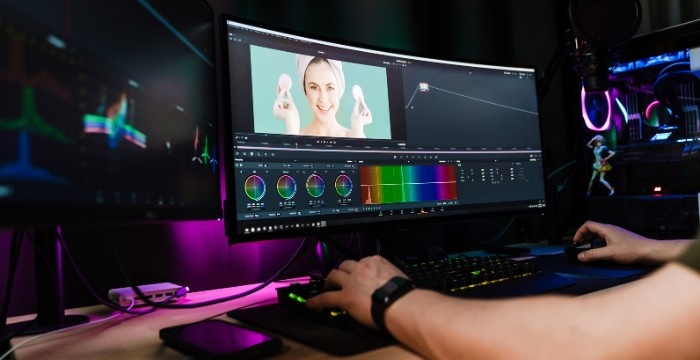Photoshop Adobe vs Canva
Introduction
Whether you’re a novice or an experienced graphic designer, the conflict between Canva and Photoshop Adobe has been building like a vibrant tempest. Imagine this: a canvas that spans to the horizon, pixelated brushes, and layers piled like weird pancakes. With its complex tools and decades-long history, Photoshop Adobe, the heavyweight king, is showing its muscles in one corner. Canva, the nimble competitor, is dancing to the tune of drag-and-drop magic and user-friendly templates in the opposite corner.
Adobe Photoshop
With the help of Adobe Photoshop, a potent picture editing program, you may create, edit, and manipulate your photos. Photoshop has many features and tools to help you be more creative, regardless matter whether you are a hobbyist, professional photographer, or digital artist. This multipurpose program is used for more than just picture editing; it is also employed in graphic design, digital painting, and the production of visual material for the online and print media. Working efficiently is made possible by the intuitive, user-friendly design, which makes it simple to customize your workplace, organize panels, and access features.
Photoshop’s layer-based structure, which makes non-destructive editing possible, is one of its best features. With this method, you may manage effects and visibility by using masks, stacking layers, and adjusting opacity. Editing requires precise choices, and Photoshop offers a number of tools to aid with this, including the Marquee, Lasso, and Magic Wand. Spot Healing Brush, Clone Stamp, and Content-Aware Fill are some of the tools that make it easy to retouch and repair images by removing undesirable items, flaws, and blemishes.
In order to apply artistic filters, modify colors, and create unusual effects, Photoshop also provides a large selection of adjustment layers and filters. Photoshop excels in typography as well, offering a wide range of customizable fonts, styles, and effects that let you add text to your photos and combine text and pictures to create visually striking designs. The brush engine in Photoshop enables users to create realistic strokes and textures for digital painting or photo touch-ups.
Canva
With the help of the flexible online graphic design tool Canva, both individuals and businesses may produce a vast array of visual content. Canva’s extensive design features, which include tools for making social media graphics, presentations, promotional goods, and websites, make it easier to design anything from digital invites to business cards to posters to social media postings. Canva was established in Australia in 2013 and provides easy-to-use design tools for both novice and expert designers. This allows anyone to generate high-quality photos and materials without having a lot of design knowledge.
Thousands of easily customizable templates are available on Canva to assist users in getting started with their design journey. These templates can be used to create totally new designs or modified to suit specific needs. To meet various needs, the site provides both free and paid alternatives. With easily customizable templates, the ability to edit pre-existing files, and the option to share or print designs, Canva Free is the perfect tool for anyone wishing to create or work on a variety of projects for free. Canva Teams offers professional workplace tools and workflows to encourage collaboration, while Canva Pro delivers premium capabilities for those building their brand or working on passion projects. Canva Enterprise enables businesses to efficiently manage teams, brands, and designs.
With AI-powered tools like Magic Studio, which includes Magic Write for creating on-brand content and Magic Edit for photo transformation, Canva further improves efficiency. In addition to managing approval channels to restrict rights, assign tasks, and distribute work across their organization, users may set up Brand Kits and templates to ensure uniform design throughout their workforce. Furthermore, Canva offers printing services that let users design and print from one location. This way, memories can be turned into picture albums, designs can be turned into T-shirts, and branding can be turned into business cards or flyers, all with quick and flexible delivery right to the customer’s door. Ultimately, the goal of Canva is to make design approachable and pleasurable for everyone, regardless of whether they are working alone, in a group, or on behalf of an organization.
Canva vs Photoshop Adobe
Features: Offering sophisticated capabilities for modifying raster-based pictures, Adobe Photoshop is an industry-standard powerhouse for photo editing and graphic design, allowing you great control over the finished product. Professional photographers and designers will find layers, masks, filters, and sophisticated colour correction to be very useful features. Conversely, Canva is meant for non-designers. It concentrates on producing final designs rapidly while offering simple editing options. Although it is easy to use and has a large selection of templates and design elements, it is not as feature-rich as Photoshop.
Cost: Canva offers a more affordable price range. Particularly when taking team plans into account, it is far less expensive than Photoshop. The monthly cost of Canva’s team subscription is $12.95. The cost of an annual single-user license for Adobe Photoshop is $79.99. Canva comes out on top in this case if price is an issue. Canva is also available to users on a tight budget, providing a restricted feature free edition.
Photo Editing: Adobe Photoshop is excellent at editing photos. It has sophisticated tools for repairing flaws, modifying photos, and accurately adjusting details. For projects requiring intricate image processing and high-quality editing, it is the recommended option. Canva concentrates more on producing finished designs with text, images, and templates and presumes that photos are already completed. It isn’t designed to be a highly functional photo editor and doesn’t have Photoshop’s sophisticated editing features.
Compatibility: In terms of compatibility, both are equal. Adobe Photoshop is a powerful desktop application that runs on both Mac and Windows computers. Because Canva is an online application that can be used on any device with an internet connection and is accessible from any location without the need to download any software, it is incredibly versatile. Canva’s accessibility for design work while on the go is further enhanced with its mobile apps.
Teamwork: There is a tie between the two. Canva makes it simple to work with teams, establish branding rules, and collaborate in real-time on projects by integrating collaboration capabilities straight into the system. With the help of Adobe Creative Cloud, Photoshop facilitates real-time collaboration among team members. It also offers shared libraries and cloud storage to enable smooth teamwork.
Ease of Use: Canva is renowned for its user-friendly drag-and-drop interface, which enables novices to create designs even in the absence of prior design knowledge. It’s the perfect tool for creating content quickly and easily because of its simplicity and large library of templates and design elements. Because of its wide range of tools and capabilities, Photoshop has a steeper learning curve even if it is more powerful; therefore, it is best suited for those who have the time to dedicate to learning the program or who have prior design expertise.
Output & File kinds: Adobe Photoshop offers a multitude of options for exporting and storing files with various quality and compression settings. It supports a large number of file kinds, including PSD, JPEG, PNG, TIFF, and more. Canva is more flexible than Photoshop when it comes to processing files and exporting options, but it still meets the majority of design demands because it supports basic formats like PNG, JPEG, and PDF.
Customization: Photoshop has a great deal of customization options. Users may make and save their own brushes, patterns, and styles, as well as use actions and scripts to automate operations. Although less customizable, Canva has a large selection of pre-designed elements and templates that are easily customizable to meet various design requirements.
Integration: Photoshop’s smooth integration with other Adobe Creative Cloud apps, such as Illustrator, InDesign, and Lightroom, gives creative professionals access to a wide range of tools. To improve its capabilities for content creation and delivery, Canva also provides interfaces with a range of third-party tools and platforms, including marketing platforms, cloud storage services, and social media outlets.
Conclusion
In conclusion, Canva is a great option for non-designers looking for a simple tool to create movies and images. It is easy to use via a web browser, has collaboration features, and is reasonably priced. Nonetheless, experts that require strong picture editing features always turn to Adobe Photoshop. Although it costs more, it offers sophisticated tools for photo manipulation and detail adjustment.
In the end, the decision you make will rely on your personal requirements and tastes. Choose Canva if simplicity and cost are your top priorities. Adobe Photoshop is the best option if you need powerful editing features and are prepared to put in the effort to learn.

